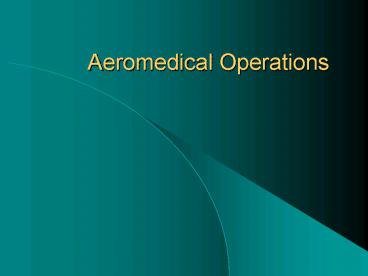Aeromedical Operations PowerPoint PPT Presentation
1 / 14
Title: Aeromedical Operations
1
Aeromedical Operations
2
Why Call The Helicopter?
- Access to interventions, equipment not available
from ground unit. (Be sure this is true before
calling for this reason.) - Access to remote areas
- Rapid patient transport.
Think of it as an ambulance that goes 200 mph in
a straight line.
3
Why Call The Helicopter?
- Trauma Score lt12
- Glasgow Scorelt10
- Penetrating trauma to head or torso
- Injuries producing paralysis, lateralizing signs
- Amputations, except digits
- gt2 Long bone fractures
- Crush injury to head or torso
- Burns of face, feet, hands, perineum
- Respiratory burns
- Electrical or chemical burns
- Patient lt12 or gt55
- Near drownings
4
Why Call The Helicopter?
- Adults with
- Systolic BP lt90
- Respiratory rate lt10 or gt35
- Heart rate lt60 or gt120
- Unresponsive to verbal stimuli
5
Why Call The Helicopter?
- Mechanism of Injury
- Unbelted vehicle rollover
- Vehicle vs. Pedestrian gt20mph
- Falls gt10ft
- Motorcycle ejection gt20mph
- Multiple victims
6
Why Call The Helicopter?
- Difficult Access
- Wilderness rescue
- Difficult road conditions, weather, traffic
- Time/Distance Factors
- Trauma center gt15 minutes
- Extrication time gt20 minutes
- Ground transport time gtAir transport time
- Ground transport would remove local coverage
7
Packaging/Transport Considerations
- Backboard size
- Traction splints
- ET tube cuffs
- MAST
- IV bag pressure infusers
- Auscultation of chest sounds
8
Landing Zone
- Flat area clear of obstructions
- Nighttime 100 feet x 100 feet
- At least 50 yards from rescue scene to minimize
rotor wash effects - Remove loose debris Wet down area with water fog
to minimize dust
9
Landing Zone
- On divided highways, stop all traffic in both
directions - Warn crew of locations of power lines, poles,
antennas, trees - Mark each corner of LZ put a 5th device on the
upwind side - NEVER point any kind of light at a helicopter on
approach at night
10
Landing Zone
- Move bystanders back at least 200 feet
- Keep emergency personnel 100 feet away during
landing - No smoking within 50 feet of aircraft
11
Communications with Crew
- Describe your location in terms of the ships
location, not yours - For example Medivac 1, we have you in sight. We
are at your 10 oclock position.
12
Operations Near Helicopters
- Secure all loose items, including hats and
stretcher sheets - Never approach until pilot signals you to
- Approach from front, keeping pilot in sight
- Approach from downhill if ship is on incline
- NEVER cross behind or underneath the ship
13
Operations Near Helicopters
- Crouch when approaching, leaving ship
- NEVER attempt to open a door or operate other
equipment on the ship - Follow ALL crew instructions exactly
14
Operations Near Helicopters
- By federal law, the pilot has absolute command
over the ship - He has final authority to determine whether or
not to attempt a mission or a maneuver - Highest priority always is given to the safety of
the ship and its crew

